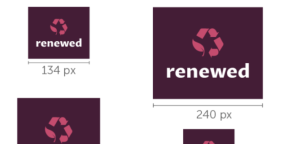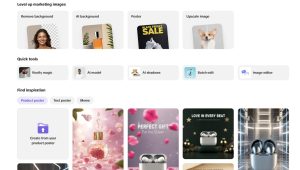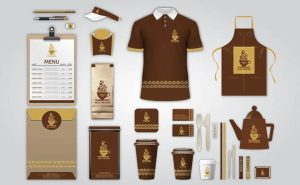Are you feeling nostalgic for the 90s? From fashion to music, the 90s left a significant impact on pop culture. Logo design was no exception. The 90s aesthetic is making a comeback, and logos are trending towards a more colorful look recently. While minimal logos like Google, Airbnb, and Spotify reigned supreme for the last decade, the 90s logos are taking over.
Let’s take a trip down memory lane with these 1990s logo designs. The 90s logo designs were influenced by pop culture and underground music. They were distinctively of the decade, yet also timeless designs in their own right. The 90s logos were bold, colorful, and playful. They were often influenced by the use of neon colors, geometric shapes, and pixel art.
The 1990s, often referred to as the “golden era,” was a time of cultural shifts, technological advancements, and memorable trends. From MTV to Nickelodeon, the 90s logos were iconic and memorable. In this article, we will explore the best 90s logos and the design trends that made them so popular. Get ready to take a trip back in time and discover the nostalgia and iconic designs of the 90s logos.
90s Logo Evolution
The 1990s were a decade of cultural shifts and technological advancements that left a significant impact on pop culture, including logo design. During this era, logos evolved from simple designs to more complex and colorful ones. Here are some of the key trends that defined the 90s logo evolution:
Bold Colors and Geometric Shapes
One of the most notable trends of 90s logos was the use of bold colors and geometric shapes. Brands like MTV, Cartoon Network, and Nickelodeon used bright and vibrant colors to attract younger audiences. The logos of these brands were often composed of simple geometric shapes, such as squares, circles, and triangles.
Gradient and 3D Effects
Another trend that emerged in the 90s was the use of gradient and 3D effects in logos. This was made possible by advancements in computer technology, which allowed designers to create more complex and realistic designs. Brands like Apple, Windows, and IBM used these effects to give their logos a more modern and futuristic look.
Minimalism and Simplicity
While many logos of the 90s were complex and colorful, there were also brands that opted for a more minimalist and simple approach. The logos of brands like Nike, Adidas, and Reebok were composed of simple shapes and typography. These logos were often designed to be easily recognizable and memorable.
Brand Evolution
Finally, many brands underwent significant logo changes during the 90s. For example, the Starbucks logo went from a simple black and white design to a more complex and colorful one that featured a green mermaid. The Pepsi logo also underwent several changes during this era, with the brand experimenting with different colors and shapes.
Overall, the 90s were a decade of significant logo evolution, with brands experimenting with bold colors, geometric shapes, gradient and 3D effects, minimalism, and brand evolution.
Impact of 90s Logos
The 1990s was a decade of cultural shifts, technological advancements, and memorable trends. Logo design was no exception. The logos of the 90s were distinctive, and they played a significant role in shaping the visual language of the era. Here are some of the ways 90s logos impacted the design industry:
Bold and Colorful Designs
The 90s were all about bold and colorful designs. Logos from this era were characterized by bright colors and bold typography. Brands were not afraid to experiment with different color combinations and patterns. Nickelodeon’s logo with an orange splat containing the company’s name is a prime example of this trend. The bright color represents youth, energy, joy, and creativity, which was perfect for the channel’s target audience of children aged six to 17.
Iconic Designs
The 90s gave birth to some of the most iconic logos that are still recognizable today. Think of the swoosh of Nike or the bitten apple of Apple. These logos have become synonymous with their respective brands and have stood the test of time. Other logos like MTV and Cartoon Network have also become iconic, and they are still relevant today.
Influence on Today’s Designs
The 90s have had a significant influence on today’s logo designs. Many brands are now adopting the retro aesthetic, which includes bright colors, bold typography, and funky patterns. The 90s have become a source of inspiration for designers who are looking to create something unique and memorable. Brands like Fanta and Sprite have recently updated their logos with a retro look to appeal to a younger audience.
In conclusion, the 90s logos were bold, colorful, and iconic. They have had a lasting impact on the design industry and continue to inspire designers today. Whether you love them or hate them, there is no denying that the logos of the 90s were a significant part of the visual language of the era.
Iconic 90s Logos
https://www.youtube.com/watch?v=KYK2imh6s6g&embed=true
The 90s was a decade of iconic logos that continue to be recognized and celebrated today. From music industry logos to tech company logos, fashion brand logos, and television network logos, the 90s brought us some of the most memorable and beloved logos of all time.
Music Industry Logos
The 90s was a time of musical revolution and many of the logos from that era have become synonymous with the artists and genres they represent. Some of the most iconic music industry logos of the 90s include:
- Nirvana: The smiley face logo that became the symbol of grunge rock and Nirvana’s iconic album “Nevermind”.
- MTV: The iconic “M” logo of the music television network that revolutionized the way we consume music and pop culture.
- Tupac: The “Makaveli” logo that represented Tupac’s alter ego and became a symbol of hip-hop culture.
Tech Company Logos
The 90s was also a time of rapid technological advancement and the logos of tech companies from that era have become some of the most recognizable in the world. Some of the most iconic tech company logos of the 90s include:
- Apple: The rainbow-colored Apple logo that represented the company’s commitment to creativity and innovation.
- Microsoft: The iconic four-square Windows logo that became synonymous with personal computing.
- AOL: The yellow and blue logo of the internet service provider that introduced millions of people to the world of online communication.
Fashion Brand Logos
The 90s was a decade of fashion experimentation and many of the logos from that era have become iconic symbols of style and culture. Some of the most iconic fashion brand logos of the 90s include:
- Tommy Hilfiger: The red, white, and blue flag logo that became a symbol of preppy style and American fashion.
- Calvin Klein: The minimalist, black and white logo that represented the brand’s commitment to simplicity and sophistication.
- GAP: The simple, all-caps logo that became synonymous with casual, comfortable clothing.
Television Network Logos
The 90s was also a time of great television programming and many of the logos from that era have become iconic symbols of popular culture. Some of the most iconic television network logos of the 90s include:
- NBC: The colorful peacock logo that represented the network’s commitment to diverse programming and entertainment.
- FOX: The bold, all-caps logo that represented the network’s edgy and irreverent approach to television programming.
- Cartoon Network: The whimsical, colorful logo that became synonymous with animated programming and childhood nostalgia.
The logos of the 90s continue to be celebrated and recognized for their creativity, innovation, and cultural significance. Whether you’re a music lover, a tech enthusiast, a fashionista, or a television fanatic, the logos of the 90s have something for everyone.
Design Elements in 90s Logos
https://www.youtube.com/watch?v=uLfA8_cxUWo&embed=true
When it comes to 90s logos, there are certain design elements that were popular during that era. These elements helped create the iconic logos that we still remember today. In this section, we’ll take a closer look at some of these design elements.
Color Choices
One of the most distinctive features of 90s logos was the use of bold and bright colors. Neon colors, in particular, were very popular during this time. These colors were often used in combination with black or white to create a high-contrast look. Some of the most popular colors used in 90s logos include:
- Neon green
- Hot pink
- Electric blue
- Bright purple
- Vibrant orange
Typography
Typography played a crucial role in 90s logos. Many logos featured bold, blocky fonts that were easy to read from a distance. Some logos also incorporated more playful, handwritten fonts. Serif fonts were less common in 90s logos, with sans-serif fonts being the preferred choice. Some of the most popular fonts used in 90s logos include:
- Helvetica
- Arial
- Impact
- Brush Script
Shapes and Symbols
Many 90s logos featured geometric shapes and symbols. Triangles, circles, and squares were all popular choices. Some logos also incorporated abstract shapes or patterns. Symbols such as stars, lightning bolts, and arrows were also commonly used. These shapes and symbols were often used in combination with bold colors and typography to create a visually striking logo.
In conclusion, 90s logos were characterized by bold colors, blocky typography, and geometric shapes and symbols. These design elements helped create some of the most iconic logos of the era.
Influence of 90s Logos on Modern Design
The 90s was a decade of bold and vibrant design, and its influence can still be seen in modern logo design. From the use of bright colors to the incorporation of organic and handwritten fonts, the 90s aesthetic has made a comeback in recent years.
One way that 90s logos have influenced modern design is through the use of gradients. Gradients were a popular design element in the 90s, and they have made a comeback in recent years. Many modern logos use gradients to create a sense of depth and dimensionality, and to add visual interest to an otherwise simple design.
Another way that 90s logos have influenced modern design is through the use of bold typography. In the 90s, typography was often used to make a statement, and it was not uncommon to see logos that consisted solely of bold, oversized text. This trend has made a comeback in recent years, with many modern logos featuring bold, sans-serif typography.
The use of patterns is another design element that was popular in the 90s and has made a comeback in modern logo design. In the 90s, patterns were often used to create a sense of movement and energy, and they were commonly found in fashion and music. Today, many modern logos use patterns to add visual interest and texture to a design.
Overall, the influence of 90s logos on modern design is undeniable. From the use of bold colors and typography to the incorporation of patterns and gradients, the 90s aesthetic has made a comeback in recent years, and it shows no signs of slowing down. Whether you love it or hate it, there’s no denying that the 90s has left a lasting impact on logo design.
Revival of 90s Logos
Are you tired of the same old minimalist logo designs? Are you looking for something more vibrant and colorful? Look no further than the revival of 90s logos!
In recent years, there has been a resurgence of interest in the bold and playful designs of the 90s. These logos were heavily influenced by pop culture and underground music, resulting in a unique aesthetic that stands out from the crowd.
One of the defining features of 90s logos is their use of bright colors and bold shapes. Unlike the muted tones and simple designs of many modern logos, 90s logos were unafraid to be loud and attention-grabbing. This makes them perfect for brands that want to stand out and make a statement.
Another hallmark of 90s logos is their use of playful fonts and typography. From bubble letters to graffiti-inspired designs, 90s logos often featured custom lettering that added to their overall aesthetic. This attention to detail and willingness to experiment with different styles is what makes 90s logos so memorable.
But the revival of 90s logos isn’t just about nostalgia. It’s also a response to the current cultural climate, where people are looking for something more authentic and meaningful. 90s logos represent a time when creativity and self-expression were valued, and brands are tapping into that spirit to connect with consumers on a deeper level.
So if you’re looking to add some personality and flair to your brand, consider taking inspiration from the iconic logos of the 90s. With their bold colors, playful typography, and unique aesthetic, they’re sure to make a lasting impression on your audience.
Marietta Arnold is a branding and design enthusiast who draws inspiration from hobbies like hiking, photography, and art exploration. With a background in graphic design, she shares insights on branding strategies and logo design trends. Stay updated with Marietta’s work for the latest in branding and design.


